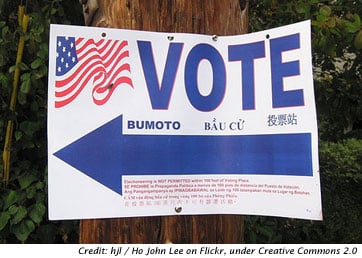
 (WOMENSENEWS)–Women’s representation in Congress–already disproportionately weak at 17 percent–could drop for the first time in 30 years in these November 2010 elections.
(WOMENSENEWS)–Women’s representation in Congress–already disproportionately weak at 17 percent–could drop for the first time in 30 years in these November 2010 elections.
But that doesn’t stop Mary Hughes, president and co-founder of Staton Hughes, a political consulting firm in San Francisco, from looking forward to another big election "year of the woman" two years from now.
Hughes, after 25 years of helping women get elected, launched the 2012 Project in July with sponsorship from the Center for American Women in Politics at Rutgers University in New Brunswick, N.J.
The project is a nonpartisan effort to invite qualified women who are 45 and older to run in two years. The group chose 2012 since it’s the next election to follow a U.S. Census, which redraws voting districts according to the country’s changing population distribution.
Such years can be opportune for new candidates because they often create new districts, which in turn mean open races that are easier to win than those involving a well-known incumbent who is up for re-election.
"Every 10 years, things shake up," said Debbie Walsh, president of the Center for American Women in Politics. "When things shake up, it’s an opportunity."
Dozens of other efforts have been made to boost women’s candidacies and some of them–such as Women’s Campaign Forum and WomenCount, both groups dedicated to providing resources to female candidates–are partners in 2012. Unlike other programs, the 2012 Project is a deliberate effort to get as many qualified women as possible excited about running and then connecting them to groups that will provide the resources and support to allow them to run.
Targeting Women Over 45
The 2012 project is aimed at women over 45 because they are more likely to run due to more financial security and a lightened load of family responsibilities.
"Many women feel a primary responsibility for their family," said Hughes. "This has created a two-track life for gifted women; they are forced to make accommodations."
The key to the project is lining up former female officeholders to invite women to run.
"The challenge is to sell public service," said Walsh. "Who better to ask to run than women who’ve already done it?"
So far, almost 50 women have joined as recruiters, including the five project faculty co-chairs:
- Polly Baca, the first Latina elected to the Colorado State Senate and former vice chair of the Democratic National Committee.
- Yvonne Brathwaite Burke, the first African American woman elected to Congress from a Western state and the first female chair of the Congressional Black Caucus.
- Jo Ann Davidson, the first female speaker of the Ohio State House and former co-chair of the Republican National Committee.
- Madeleine Kunin, the first and only female governor of Vermont.
- Connie Morella, the first woman elected to Congress from her district in Maryland.
In order to get the most qualified candidates, the recruiters plan to speak at more than 200 conferences, conventions and gatherings of women in industries currently underrepresented in government, including finance, technology, science, energy, environment, international relations, health and small business.
"What we have now in Congress is an institution that is largely attorneys and men," said Walsh.
Invitations at Project’s Heart
Walsh says the invitation element at the heart of the 2012 Project is essential for expanding women’s numbers in Congress.
Fifty-three percent of women elected to state legislatures had not seriously thought about running until they were asked, she says, compared to 28 percent of men.
When you look at representatives who say running was their own idea those gender figures change places: 43 percent of men compared to 26 percent of the women.
"Women don’t get asked as much by party leaders," said Walsh. "If either party wanted more women in office, there would be more women in office."
The year 2012 was chosen to recreate the conditions of 1992, when state district lines were redrawn after the 1990 Census and a historic number of women were brought to office. Women secured 47 seats in the House (up from 28) and seven in the Senate (up from three), bringing women’s overall congressional representation from 5.8 percent to 10 percent.
Instead of marking the start of a sustained growth, however, 1992 began a plateau, in which women’s representation inched higher, taking 18 years to reach the current level of 17 percent.
"It’s been a very slow growth of women in Congress, flat-lining at the state level," said Walsh.
Once women announce their candidacies the project will help them take the next step by connecting them with training and leadership programs, fundraising networks and political support organizations across the political spectrum.
"We don’t endorse candidates, we don’t give them money. We connect them to available resources," said Walsh.
Would you like to Comment but not sure how? Visit our help page at https://womensenews.org/help-making-comments-womens-enews-stories.
Would you like to Send Along a Link of This Story?
https://womensenews.org/story/campaign-trail/101025/year-the-woman-part-ii-agenda-2012?page=0,1
Colleen Flaherty is a Women’s eNews editorial intern and journalism major at Minnesota State University, Mankato.
For more information:
The 2012 Project:
http://www.cawp.rutgers.edu/education_training/2012Project/index.php
Research for the 2012 Project was based on "Poised to Run," a study by the Center for American Women and Politics:
http://www.cawp.rutgers.edu/research/reports/PoisedtoRun.pdf
Center for American Women in Politics:
http://www.cawp.rutgers.edu/


